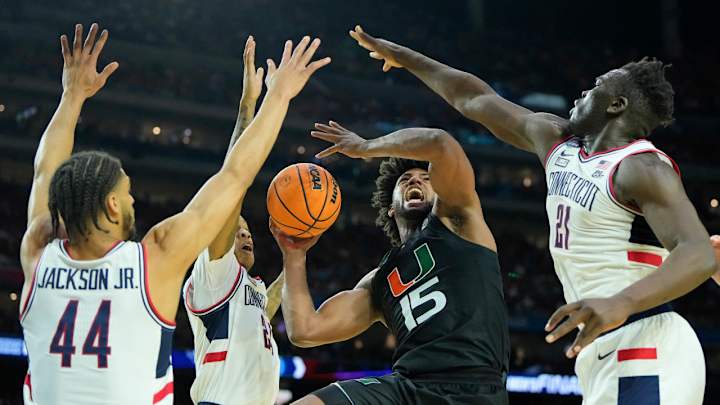Miami's Poor Shooting and Rebounding Lead to 72-59 loss to UConn

In this story:
It is hard to win a basketball game when a team shoots less than 40% from the field... and from 3-point range. Miami shot less than 33% and 35% from 3-point land. It was the downfall for the Hurricanes as they lost the first Final Four appearance in school history to the UConn Huskies, 72-59.
Miami's shooting percentage from three was higher than UConn's. However, UConn shot 49.1% from the field and outrebounded the Hurricanes 41-32.
One of the main projections of the game was the size disadvantage Miami faced against UConn. In the first half, the Huskies' size was not as prevalent. The Canes had seven more offensive rebounds while trailing by two in the total rebound count (21-19).
While the Canes had a slight answer for the size in the first half, they never could contain UConn forward Adama Sanogo. Sanogo had 12 points and five rebounds at the half. Sanogo finished with 21 points, going 9-11 from the field and 10 rebounds.
Norchad Omier has been Miami's most talented big man, but lost this battle and finished with eight points and seven rebounds. He also found himself in foul trouble as he finished with four. To compare, Sanogo had one.
Alex Karaban, a 6-foot-8 freshman, had eight points and nine rebounds for UConn. To add insult to injury, when UConn coach Dan Hurley wanted to really outsize Miami, he checked in Donovan Clingan, a 7-foot-2 freshman center. Clingan finished with six rebounds and four points.
There's 8:26 to play, #UConn leads #Miami 60-45 on the scoreboard and holds a 34-24 advantage on the boards, too.
— All Hurricanes (@AllHurricanes) April 2, 2023
A major reason has been Sanogo, but Karaban and Clingan have been good on the backboard as well. The three have combined for 21 rebounds.#MarchMadness
The size UConn possesses made it difficult for the Hurricanes to make an impact on the inside, and the Canes also missed more than 10 shots from point-blank range. With UConn's size advantage, Miami didn't do itself any favors by missing some relatively easy buckets.
Miami guards Isaiah Wong and Jordan Miller both went 4-10 from the field. Miller missed his only 3-point attempt while Wong went 2-4 from 3-point range.
Canes guard Nijel Pack went 3-10 from the field and scored eight points and made no trips to the charity stripe.
As the Hurricanes struggled to make shots on the inside, they decided to go to the perimeter, where they excelled all tournament long. Miami shot 7-20 from 3-point land, 35%.
No matter what the Hurricanes did, UConn had an answer, even from the very tip. Miami never led in the ballgame. UConn's largest lead of the game was 20.
Miami did not play its best brand of basketball on Saturday night. Compared to the season averages, Miami fell short in rebounding, assists, points and shooting percentage.
The only statistical categories Miami had better on Saturday night than it did during the course of the season were fouls and turnovers.
Miami coach Jim Larrañaga said postgame the message he gave his team was one he remembered from a television show he used to watch called Wide World of Sports.
"The thrill of victory and the agony of defeat."
Larranaga said that last weekend, his team experienced the thrill of victory and making history. But, on Saturday, he said his team had to experience the latter.
AllHurricanes.com is your home for all things Miami Hurricanes football, recruiting, basketball and other athletics, all the time. Follow along on social media at @AllHurricanes on Twitter and All Hurricanes on Facebook for round-the-clock news and analysis.
